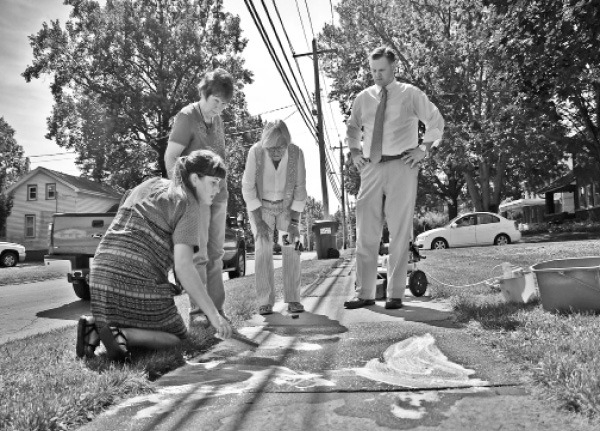
ERASE HATE
first performed on September 3, 2017
A sidewalk in front of Hampshire Colony Congregational Church, Princeton, Illinois
performed once in 2017
REBECCA KAUTZ
Madison, WI
711428710r711428710e711428710b711428710e711428710c711428710c711428710a711428710m711428710k711428710a711428710u711428710t711428710z711428710@711428710y711428710a711428710h711428710o711428710o711428710.711428710c711428710o711428710m
rebeccakautz.com
ERASE HATE
REBECCA KAUTZ
I grew up in a small rural town in Illinois. I return home on a regular basis to visit my parents who live on the corner of Park Street and Church Street. A few doors from their home, on Church Street, is the Hampshire Colony Congregational Church. While visiting in 2016, I noticed a large, green swastika spray painted on the sidewalk directly in front of the church and near the front door. I noticed it on several occasions while walking near my family’s home on separate visits. While visiting for Labor Day Weekend, I noticed it still had not been removed when on an early walk with my two young children. It was Sunday, September 3, 2017 and the day before Labor Day. It was early in the morning before the Church Service began. I went into the church and was introduced to the Minister where I explained my frustration, disappointment, and determination to remove the symbol on that day. I informed him that I would be performing the “Erase Hate” action at the end of the service when the church members were leaving so that they could witness the performance. The minister told me that the Swastika was backward and therefore he believed “it was a blessing.” I explained that it sends a message of hate at the front doors, and should not be have been permitted to remain for well over a year. I told him I was offended and that he was naïve to believe that. A parishioner told me during the performance that “she had asked that it be removed and was told that they didn’t want to draw attention to it.” I borrowed a power-washer from the church after the chemical attempts failed. The high power-washer removed the swastika after 2 hours of work. This performance action is an example of socially engaged work and blurs the line between life, art, and activism. This was a spontaneous, conceptual action that made a spectacle of myself for the purpose of making a salient and crucial point. Complacent silence and indifference serve no one except the oppressor and implicates those who stand idly by. We should all be willing to make a spectacle.